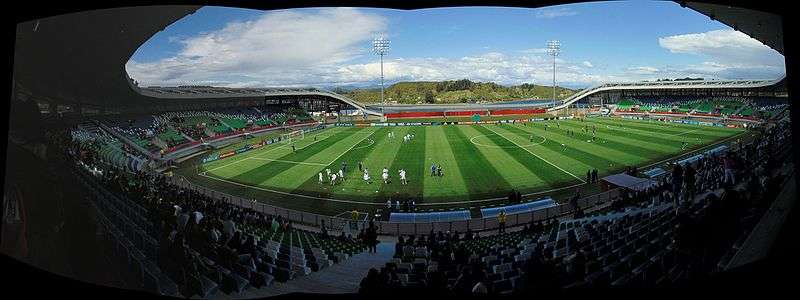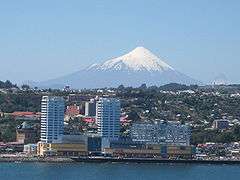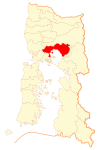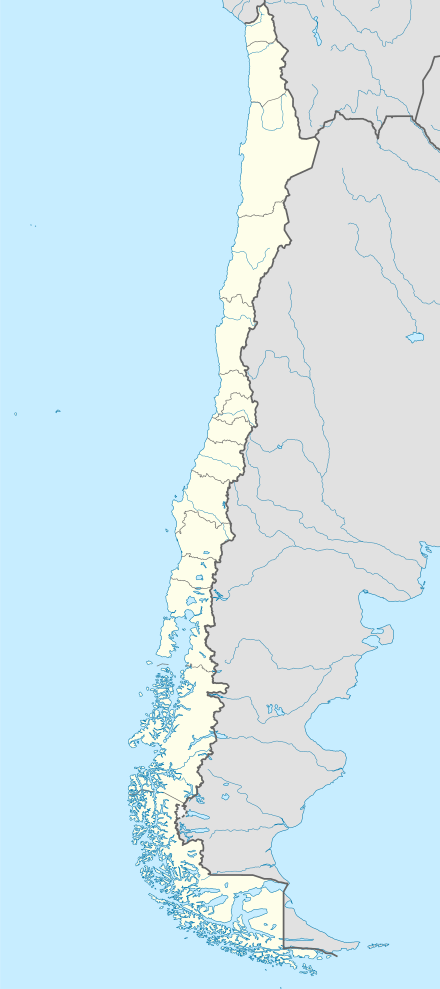Puerto Montt
| Puerto Montt Meli Pulli | ||||||
|---|---|---|---|---|---|---|
| City and Commune | ||||||
 Nocturnal view. | ||||||
| ||||||
| Coordinates (city): 41°28′S 72°56′W / 41.467°S 72.933°WCoordinates: 41°28′S 72°56′W / 41.467°S 72.933°W | ||||||
| Country | Chile | |||||
| Region | Los Lagos | |||||
| Province | Llanquihue | |||||
| Founded as | Melipulli | |||||
| Founded | 12 February 1853 | |||||
| Named for | Manuel Montt | |||||
| Government[1] | ||||||
| • Type | Municipality | |||||
| • Alcalde | Gervoy Paredes Rojas (PS) | |||||
| Area[2] | ||||||
| • Total | 1,673.0 km2 (645.9 sq mi) | |||||
| Elevation | 14 m (46 ft) | |||||
| Population (2012 Census)[3] | ||||||
| • Total | 218,858 | |||||
| • Density | 130/km2 (340/sq mi) | |||||
| • Urban | 192,473 | |||||
| • Rural | 26,385 | |||||
| Demonym(s) |
Puertomontino -a or Melipullian | |||||
| Sex[3] | ||||||
| • Men | 107,748 | |||||
| • Women | 111,110 | |||||
| Time zone | UTC−4 (CLT) | |||||
| • Summer (DST) | UTC−3 (CLST) | |||||
| Postal code | 5480000 | |||||
| Area code(s) | 56 + 65 | |||||
| Climate | Cfb | |||||
| Website | Official website (in Spanish) | |||||
Puerto Montt is a port city and commune in southern Chile, located at the northern end of the Reloncaví Sound in the Llanquihue Province, Los Lagos Region, 1,055 km to the south of the capital, Santiago. The commune spans an area of 1,673 km2 (646 sq mi) and had a population of 175,938 in 2002. It is bounded by the communes of Puerto Varas to the north, Cochamó to the east and southeast, Calbuco to the southwest and Maullín and Los Muermos to the west.
Founded as late as 1853 during the German colonization of southern Chile, Puerto Montt soon outgrew older neighboring cities due to its strategic position at the southern end of the Chilean Central Valley being a gateway city into Chiloé Archipelago, Llanquihue and Nahuel Huapi lakes and Western Patagonia.
Puerto Montt has gained renown and grown significantly due to the rise of Chile as the second largest salmon producer of the world during the 1990s and 2000s. However, the Chilean salmon aquaculture crisis of the late 2000s resulted at least temporarily in severe unemployment and exposed weaknesses in the local economy. The city's cultural heritage mixes elements of Chiloé culture with German heritage although the city has attracted a significant number of newcomers from all over Chile in the last 30 years due to employment opportunities.
History
Originally, the site was covered by thick forest and was called Melipulli (which means "four hills" in Mapudungun). It was selected as an entrance to Lake Llanquihue when its proximity to the open sea was discovered. The expedition was entrusted to Bernardo Philippi, a German naturalist and cartographer, but after his death in 1851, Vicente Perez Rosales took over his duties, and by the end of September started to chop trees at Reloncaví sound using local woodsman coming from Huar, Maillen, Huelmo and Calbuco Mainly. By December, after the forest was cut down, the area was burned to clear the land in anticipation of completing the settlement plan.[4] The city itself was founded on February 12, 1853, after government-sponsored immigration from Germany that began in 1848 populated the region and integrated it politically to the rest of the country. It was named after Manuel Montt, President of Chile between 1851 and 1861, who set in motion the German immigration.
In 1912, the city was connected by train with Santiago, making it an important point of entry to the Chilean Patagonia as well as increasing quickly the commercial and transport development. By 1950 It had a population of 27500 with an important increase of demographics and urbanization. but an earthquake that took place in May 1960 destroyed Puerto Montt, by collapsing the port, the train station and destroying many building and houses. With time it recovered thus giving a new city, becoming more modern, more populated, a more important urban centre in the zone as well as a port of national interest.[5]
1969 violence
Main article Massacre of Puerto Montt
At the start of March 1969, approximately 90 landless persons received advice from Socialist member of parliament Luis Espinoza due to the local authority never granting them any land they needed to build homes. On March 4, 1969, they settled on farmland belonging to an absentee landlord. Having been denied titles by the local authorities, these families simply moved onto the empty, unoccupied land. They did so seeking squatters' rights, and without making any payment of rent. Some four or five days later, the local Police Chief Rolando Rodríguez Marbán reassured the squatters that they would not be disturbed and could proceed with their home construction. However, a change of plans by the ministry of the interior quickly led to new orders.
At midnight on March 9, Luis Espinoza was charged with breaking the law, arrested, and moved to the city of Valdivia. Following direct orders from Interior Minister Edmundo Pérez Zujovic, 250 armed policemen launched an assault on the squatting families that dawn. Eight of the landless persons were shot dead and two, a 9-month child and an adult, died afterwards. All of the newly built homes were burned to the ground.[6] The massacre is poignantly memorialized by singer-songwriter Víctor Jara in his song Preguntas por Puerto Montt.
The massacre of Puerto Montt and the public outcry that followed were major factors contributing to the defeat of Eduardo Frei's party in the Chilean presidential election of 1970 which was succeeded by Salvador Allende's Unidad Popular.
By 1979 Puerto Montt was nominated and later becoming it, the Capital of Los Lagos Region as being the principal administrative, political and commercial centre in Southern Chile.[7]
Demographics
According to the 2002 census of the National Statistics Institute, Puerto Montt spans an area of 1,673 km2 (646 sq mi);[2] according to the 2012 census it has 218,858 inhabitants (107,748 men and 111,110 women). Of these, 192,473 (87.9%) lived in urban areas and 26,385 (12.1%) in rural areas. The population grew by 24.4% (42,920 persons) between the 2002 and 2012 censuses.[3]
Climate
Puerto Montt has a wet oceanic climate (Köppen: Cfb) with heavy rainfall throughout the year but a drying trend in the summer. Although temperatures are consistently below 25 °C (77 °F), frosts are very rare and occur only a couple of times per month in the winter. For the 41st parallel south, closer to the equator than to the south pole, Puerto Montt is much cooler than areas further inland in terms of summer temperatures, due to cool ocean currents nearby. This is compounded by the lack of a sizeable landmass on those parallels in the southern hemisphere (see also Wellington, New Zealand, which is also at a similar latitude). That means that Puerto Montt has much cooler summers than areas at similar distances from the equator in the northern hemisphere, with the only exception being the Northern California coastline, also being affected by cool Pacific currents.
| Climate data for Puerto Montt (El Tepual Airport) 1970–2000, extremes 1964–present | |||||||||||||
|---|---|---|---|---|---|---|---|---|---|---|---|---|---|
| Month | Jan | Feb | Mar | Apr | May | Jun | Jul | Aug | Sep | Oct | Nov | Dec | Year |
| Record high °C (°F) | 34.7 (94.5) |
31.4 (88.5) |
31.6 (88.9) |
25.8 (78.4) |
20.8 (69.4) |
20.0 (68) |
20.9 (69.6) |
19.9 (67.8) |
24.2 (75.6) |
24.8 (76.6) |
28.1 (82.6) |
30.4 (86.7) |
34.7 (94.5) |
| Average high °C (°F) | 19.2 (66.6) |
18.9 (66) |
17.4 (63.3) |
14.8 (58.6) |
12.4 (54.3) |
10.2 (50.4) |
9.9 (49.8) |
10.8 (51.4) |
12.4 (54.3) |
14.2 (57.6) |
16.0 (60.8) |
18.0 (64.4) |
14.5 (58.1) |
| Daily mean °C (°F) | 14.3 (57.7) |
13.9 (57) |
12.5 (54.5) |
10.5 (50.9) |
9.0 (48.2) |
6.9 (44.4) |
6.5 (43.7) |
7.0 (44.6) |
8.2 (46.8) |
9.7 (49.5) |
11.5 (52.7) |
13.3 (55.9) |
10.3 (50.5) |
| Average low °C (°F) | 9.4 (48.9) |
9.0 (48.2) |
8.0 (46.4) |
6.6 (43.9) |
5.9 (42.6) |
3.9 (39) |
3.5 (38.3) |
3.7 (38.7) |
4.4 (39.9) |
5.6 (42.1) |
7.1 (44.8) |
8.6 (47.5) |
6.3 (43.3) |
| Record low °C (°F) | 0.9 (33.6) |
0.4 (32.7) |
−0.8 (30.6) |
−3.4 (25.9) |
−6.0 (21.2) |
−6.4 (20.5) |
−7.1 (19.2) |
−5.1 (22.8) |
−5.4 (22.3) |
−2.3 (27.9) |
−0.5 (31.1) |
−0.3 (31.5) |
−7.1 (19.2) |
| Average precipitation mm (inches) | 89.8 (3.535) |
82.3 (3.24) |
94.6 (3.724) |
146.9 (5.783) |
222.1 (8.744) |
235.9 (9.287) |
218.3 (8.594) |
188.9 (7.437) |
141.9 (5.587) |
128.4 (5.055) |
109.9 (4.327) |
105.8 (4.165) |
1,764.8 (69.478) |
| Average precipitation days | 14 | 12 | 15 | 19 | 22 | 22 | 22 | 22 | 20 | 19 | 17 | 15 | 219 |
| Average relative humidity (%) | 79 | 81 | 84 | 88 | 90 | 91 | 90 | 88 | 85 | 83 | 81 | 80 | 85 |
| Mean monthly sunshine hours | 226.3 | 211.9 | 167.4 | 123.0 | 80.6 | 60.0 | 74.4 | 102.3 | 129.0 | 155.0 | 171.0 | 213.9 | 1,714.8 |
| Mean daily sunshine hours | 7.3 | 7.5 | 5.4 | 4.1 | 2.6 | 2.0 | 2.4 | 3.3 | 4.3 | 5.0 | 6.7 | 6.9 | 4.8 |
| Source #1: Dirección Meteorológica de Chile[8][9] | |||||||||||||
| Source #2: Universidad de Chile (sunshine hours only)[10] | |||||||||||||
Economy
Puerto Montt is the capital of the Los Lagos Region and the Llanquihue Province, and the main sea port at the lower end of Chile's western continental land. The city is the principal commercial, services, and financial hub of the Chilean Northern Patagonia—Zona Austral. As the geographic region's main port, Puerto Montt is often considered the 'capital' of Chilean Patagonia.
Puerto Montt is also the gateway to the Chiloé Archipelago and Chiloé Island across the Chacao Channel, and the many other smaller islands in Chile's inland Sea of Chiloé.
The city's economy is now based upon agriculture, cattle, and forestry on the surrounding islands, and fishing and salmon aquaculture in the fjords and nearby Pacific Ocean.
- Salmon aquaculture
The city is configured as the hub of one of the largest salmon aquaculture industries in the world. Hatcheries, fisheries and packing plants are mostly located south of Puerto Montt. Fresh salmon is flown daily to world markets and frozen salmon is shipped by ocean to all destinations. The tremendous growth of the region, mainly due to the salmon industry, but also due to rapid expansion of forestry, cattle, and tourism, has proven the massive economic potential of Puerto Montt and its surrounding area.
- Airports
Puerto Montt has the El Tepual Airport, where two airlines operate regular flights to and from Santiago, Punta Arenas, Balmaceda, Concepción, Temuco and Bariloche (Argentina). The airlines operating at the airport are LAN Airlines (the country's largest) and Sky Airline. The flight time to Santiago is approximately two hours.
Administration
As a commune, Puerto Montt is a third-level administrative division of Chile administered by a municipal council, headed by an Alcalde with 10 councilors and represented in the Chamber of Deputies by 5 members and in the Senate by 2 people and with support of a Regional Council of 6 members.[11]
Since 2012 the current Mayor has been Gervoy Paredes Rojas whom was reelected at 2016 Municipal elections with an end term up to 2020 and the current members of the council are Fernado España España (PS), Sonia Hernandez Asencio (PS), Luis Matamala Almonacid (PDC), Veronica Sanchez Silva (PDC), Juan Carlos Cuitiño Uribe (GEP), Rodrigo Wainraihgt Galilea (RN), Fernando Orellana Perez (RN), Marcia Muñoz Cochifas (IND), Hector Ulloa Aguilera (PPD) and Leonardo Gonzales Saez (PPD).[12]
Within the electoral division of chile, Representatives of Puerto montt, District 26 (Puerto Montt, Cochamó, Maullín, Calbuco, Castro, Ancud, Quemchi, Dalcahue, Curaco de Vélez, Quinchao, Puqueldón, Chonchi, Queilén, Quellón, Chaitén, Hualaihué. Futaleufú and Palena) in the Chambers of Deputies 2018-2022 are Jenny Álvarez Vera (PS), Gabriel Ascencio Mansilla (PDC), Alejandro Santana Tirachini (RN), Carlos Kuschel Silva (RN) and Alejandro Bernales (Liberal Party). The current Representatives in the Senate period 2014-2022 are Rabindranath Quinteros Lara (PS) and Ivan Moreira Barros (UDI). The latest one currently in Desafuero. Regional councilors members 2018-2022 are Ricardo Kuschel Silva (RN), Jaime Brahm Barril (RN), Juan Ortiz Roble (UDI), Manuel Rivera Altamirano (PS), Juan Carcamo Carcamo (PDC) and Valentina Alvarez (Ind/PPD).[13][14][15]
Education
Puerto Montt has 175 registered school varying from educational levels such as pre-school, primary school, secondary school, special school as well as technical-professional and adult schools.[16]
- Arabe Siria School is a Catholic, public school teaching from pre-school to primary school.
- Alerce Rural School is a Catholic, public school from pre-school to primary school with some support to children with special needs.
- Angelmo Elementary School is a public school with education levels from pre-school to primary school with support to children with special needs.
- Adventist Private School is a religious, private and subsidized school owned by Seventh-day Adventist Church Corporation and teach from pre-school to primary school.[17]
- Pumahue School, member of Cognita School is a private, non-subsidized school, from pre-school to secondary school.[18][19]
- Salesiano Padre Jose Fernández Perez, is a Catholic, private and subsided school, that ranging from pre-school to secondary school with support to children with special needs, as well as technical and adults school.[20]
- Deutsche Schule (German Institute) of Puerto Montt is a private, non-subsidized school member of DS CHILE "Association of German schools in Chile" with an international exchange and support from Germany, teaching from pre-school to secondary school.[21][22]
- Industrial Lyceum of Puerto Montt is a public, secondary school with a focus on technical professions.
- Lafquen Montessori School, Known to use Montessori method is a private and subsidized school, from pre-school to secondary-school with support to children with special needs.[23]
- Mother Isabel Larragaña Adult school is a Catholic and Private school with a primary and secondary school program for adults.[24]
- Joaquin de los Andes Auditory and Language Special School is an holistic, private and subsidized school for pre-school children with SLI and Deafness.[25]
Universities
- Universidad de Los Lagos, Campus Puerto Montt (Chinquihue)[26]
- Universidad Austral de Chile (UACh), Campus Puerto Montt[27]
- Universidad San Sebastián, Campus Patagonia[28]
- Universidad Santo Tomás, Campus Puerto Montt[29]
Gallery
 The city of Puerto Montt in 1862.
The city of Puerto Montt in 1862.- Angelmó.

 View of Puerto Montt's sea-side downtown in foreground and Osorno volcano in the background.
View of Puerto Montt's sea-side downtown in foreground and Osorno volcano in the background.
References
- ↑ "Municipality of Puerto Montt" (in Spanish). Retrieved 1 January 2011.
- 1 2 "National Statistics Institute" (in Spanish). Retrieved 13 December 2010.
- 1 2 3 Instituto Nacional de Estadísticas (February 2014). "Resultados XVIII Censo de Población 2012" [Results of the XVIII Population Census 2012] (PDF) (in Spanish). p. 54. Retrieved 23 March 2014.
- ↑ César A. Sánchez Vera. "Historia de Puerto Montt". Diario El Llanquihue. Retrieved April 20, 2016.
- ↑ "Puerto Montt 1853-2002". Memoria Chilena. Retrieved April 20, 2016.
- ↑ "Chile: 9 de marzo de 1969, masacre en Puerto Montt, ni olvido, ni perdón". Correo de los trabajadores. Retrieved April 17, 2016.
- ↑ Oficina Municipal de Patrimonio Cultural. "Historia". Municipalidad de Puerto Montt. Retrieved April 20, 2016.
- ↑ "Estadistica Climatologica Tomo II" (PDF) (in Spanish). Dirección General de Aeronáutica Civil. March 2001. Retrieved December 25, 2012.
- ↑ "Temperatura Mensual Histórica de El Tepual Puerto Montt Ad. (410005)". Sistema de Administración de Datos Climatológicos (in Spanish). Dirección Meteorológica de Chile. Archived from the original on June 3, 2016. Retrieved May 25, 2016.
- ↑ "Tabla 4.6: Medias mensuales de horas de sol diarias extraídas del WRDC ruso (en (hrs./dia))" (PDF). Elementos Para La Creación de Un Manual de Buenas Prácticas Para Instalaciones Solares Térmicas Domiciliarias (in Spanish). Universidad de Chile. September 2007. p. 81. Retrieved 21 January 2015.
- ↑ "Servicio Electoral de Chile". Retrieved January 21, 2018.
- ↑ "Municipal Council Members of Puerto Montt". Retrieved January 21, 2018.
- ↑ "Chamber of Deputies of Chile". Retrieved January 21, 2018.
- ↑ "Senate of Chile". Retrieved January 21, 2018.
- ↑ "Regional Council X Region de Los Lagos". Retrieved January 21, 2018.
- ↑ "Full guide of Education in Chile" (in Spanish). Retrieved 6 February 2018.
- ↑ "Adventist School of Puerto Montt" (in Spanish). Retrieved 6 February 2018.
- ↑ "Pumahue School Puerto Montt" (in Spanish). Retrieved 6 February 2018.
- ↑ "Cognita Group". Retrieved 6 February 2018.
- ↑ "COLEGIO SALESIANO P. José Fernández Pérez" (in Spanish). Retrieved 6 February 2018.
- ↑ "German School Puerto Montt" (in Spanish). Retrieved 6 February 2018.
- ↑ "Deutscher Bundestag 4. Wahlperiode Drucksache IV/3672" (Archive). Bundestag (West Germany). 23 June 1965. Retrieved on 12 March 2016. p. 23/51.
- ↑ "Lafquen Montessori School" (in Spanish). Retrieved 6 February 2018.
- ↑ "Hermanas de la caridad del Sagrado Corazon de Jesus" (in Spanish). Retrieved 6 February 2018.
- ↑ "Joaquin de los Andes Puerto Montt" (in Spanish). Retrieved 6 February 2018.
- ↑ http://www.puertomontt.ulagos.cl/
- ↑ http://www.pmontt.uach.cl/
- ↑ http://www.uss.cl/blog/sedes/puerto-montt-patagonia/descripcion/
- ↑ http://www.ust.cl/sedes/puerto-montt/
Notes
External links
![]()




